Integral Geopolitics, Part One: The West isn't Western, Ray Harris (original) (raw)
TRANSLATE THIS ARTICLE
Integral World: Exploring Theories of Everything
An independent forum for a critical discussion of the integral philosophy of Ken Wilber
 Ray Harris is a frequent contributor to this website. He has written articles on 9/11, boomeritis, the Iraq war and Third Way politics. Since 2007 he took to writing his novels Navaratri, Wild Child and Eden.
Ray Harris is a frequent contributor to this website. He has written articles on 9/11, boomeritis, the Iraq war and Third Way politics. Since 2007 he took to writing his novels Navaratri, Wild Child and Eden.
Harris lives in Ballarat, Victoria, Australia
.
Part 1 | Part 2 | Part 3 |Part 4 | Part 5
Part 1: The West isn't Western
Ray Harris
A QUICK HISTORICAL OVERVIEW
There is no more absurd a concept than the Global South. The term was invented to assuage some politician's sense of pride.
It seems an extraordinary thing to say, but of course, on a globe the idea of east and west only makes sense when there is a reference point. North and south are easier because of the two poles; halfway is the equator. But where is the line separating east and west?
And what does this mean for the idea of 'Western' civilisation and especially those who say they are opposed to the West?
When asked, most people will regurgitate half-understood lessons from their childhood. Western civilisation is based on Judeo-Christian values and/or Greco-Roman civilisation. Let's examine both of these more closely.
The Greeks
When Alexander set out to conquer the world he headed south and east, not west. After his death, the empire was divided between his generals. Called the Diadochi, it covered most of what we now call the Middle East. The two significant regions were Ptolemaic Egypt and Seleucid Persia.
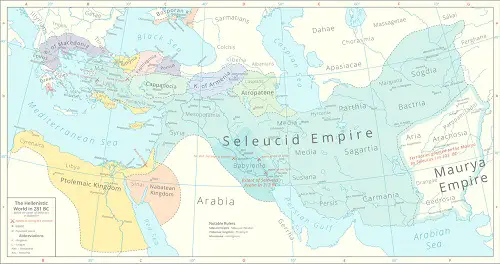
The Hellenistic World in 281 BC.
Of particular interest is the Greco-Buddhist regions of Bactria and Ghandara. Here we see a clear fusion of Greek and Hindu culture. The Greeks encounter Indian philosophers they call gymnosophists, or naked sages, and the Indians encounter Greek costume and sculpture, which was to have a particular influence on later Buddhist iconography.
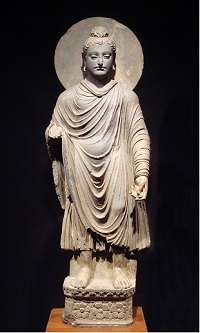
A Greek influenced Buddha
Recent research and debate has suggested a closer link between Greek and Indian philosophy than first thought, although the loss of documentation over time makes it difficult to know with any certainty. It is certainly known that Pyrrho, the founder of Scepticism, travelled with Alexander and met with both Persian magi and Indian sages. This raises the question of influence. Was Pyrrho influenced by Indian philosophy or had he merely reached the same conclusions (called parallelism)? It is said that Pyrrho was an eccentric character who preferred to live outside convention, maintaining a state of ataraxia, or equanimity. Those familiar with Indian philosophy might see a similarity to the tradition of the avadhut.
The issue of commonality also arises with another established 'Western' tradition, Stoicism. Many have pointed out the similarities to Buddhism, minus of course, the belief in reincarnation. Again, both Stoicism and Buddhism teach that attachment is the cause of suffering.
And it works both ways. Other writers have suggested that the Buddhist philosopher Nagarjuna came into contact with Greek ideas, which influenced the development of the madhyamika school. We also know that the emperor Ashoka sent Buddhist missionaries to Greece, Syria and Egypt.
Let's now travel west, through the lands of the Zoroastrian Magi to the Egypt of the Ptolemaic Dynasty and the new capital of Alexandria. Here Greek philosophy meets the mystery cults of the Egyptians. The key figure here is Ptolemy II Philadelphus. He completes the Great Library at Alexandria, sends emissaries to purchase scrolls to fill the library and funds scholars to study and maintain the scrolls. He also sends diplomats to India and establishes the port of Berenike (named after his mother, Berenice), which served as an important point on the trade route with India.
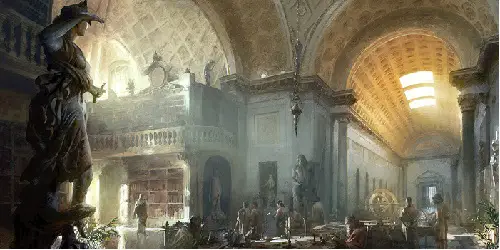
An artist's impression
It is clear from both the archaeological and documentary evidence that the city of Alexander was fully aware of Indian philosophy. In Bk 1, Ch XV of his Stromata, Bishop Clement of Alexandria writes:
“The Indian gymnosophists are also in the number, and the other barbarian philosophers. And of these there are two classes, some of them called Sarmanæ [ascetics] and others Brahmins. And those of the Sarmanæ who are called "Hylobii" neither inhabit cities, nor have roofs over them, but are clothed in the bark of trees, feed on nuts, and drink water in their hands. Like those called Encratites in the present day, they know not marriage nor begetting of children. Some, too, of the Indians obey the precepts of Buddha (Βούττα) whom, on account of his extraordinary sanctity, they have raised to divine honours.”
The Romans
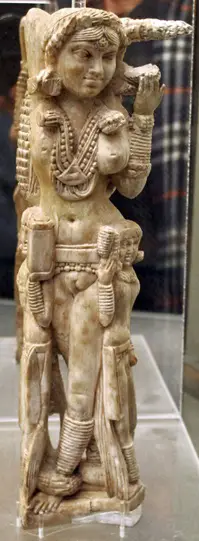
As we know, the Romans come to dominate the Hellenic world. They embrace Greek learning and integrate the Greek gods with their own creating a unified Greco-Roman world. This world is remarkably cosmopolitan with Africans mixing with Scythians and eventually with Celts from Gaul and Britannia. African and Syrian regiments are known to have been stationed at Hadrian's Wall. And whilst it is known that Roman rule only extended as far east as Iraq and the Arab sea (the Seleucid empire having been absorbed by the later Parthian and Sassanid empires), it nonetheless maintained a strong trade relationship with India and China, at one point being at a deficit. The Silk Road. The Arab sea rout. Roman coins have been found throughout India and Indian artefacts in Rome, including the famous Lakshmi of Pompeii.
Roman society was also remarkably tolerant of foreign religion, provided they didn't challenge Imperial authority. Again, the archaeological evidence is clear that the Romans tolerated local beliefs and that there was even some syncretism, whether it was in Britannia, Dacia, Africa or Mesopotamia. Some of these cults made their way to Rome. Two in particular stand out. The Cult of Isis from Egypt and the cult of Mithra from Persia.
The Roman elites were educated in Greek philosophy, and whilst many patricians engaged in the mundane political intrigues of the day, Rome did produce an intellectual class: Lucretius, Cicero, Seneca, Pliny (the elder and younger), Porphyry. Again, two in particular stand out: Emperor Marcus Aurelias for his significant contribution to Stoic philosophy and Plotinus, the founder of Neo-Platonism. It is worth noting that Plotinus was well aware of the famed philosophers of India and he was inspired to attempt (a failed journey) to Persia and India. He was also involved in plans with the Empress Cornelia Salonina (wife of Gallienus) to build an entire city devoted to philosophy to be called Platonoplis - a rival to Alexandria.
In summary - Greco-Roman civilisation transcends geography. It spans a vast territory that includes multiple ethnicities and belief systems, from the Nubia of Sudan to the redhead Picts of Albion and the Buddhists of India. It is categorically not 'Western'. It is cosmopolitan.
Christianity
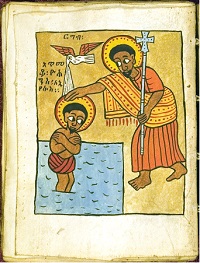
In Ethiopia Jesus is depicted as Black
From a strictly historical perspective Judaism is the product of cultural synthesis. The patriarch Abraham is born somewhere in Sumer. Originally a Canaanite group, the Hebrews begin to develop their own religion under the influence of Egypt and Babylon. It distinguishes itself as a defiantly independent religion in conflict with any attempt at domination by outside forces. Despite multiple revolts, Judaism is inevitably influenced by both Greek and Roman culture. The province of Syria-Palestina is fertile ground for a multiplicity of novel religious leaders and cults, from the Zealots, Theraputae, Essenes, John the Baptist (Mandaeans), etc. Several leaders who claim the title messiah appear; one in particular, Yeshua bin Yussef, rises to prominence.
The new sect of Christianity spreads throughout the Roman world. Christian missionaries travel to India, Ethiopia and to Ireland.
Sectarian interpretations jostle for dominance, a process that takes centuries. Rival sects are declared heretical. Christian zealots attack Greco-Roman culture, statues are vandalised, temples destroyed and libraries and schools burnt. This period is schizophrenic because some Christians act to preserve Greco-Roman learning, whilst others hunt down heretics. Christian theologians turn to Plato and Aristotle. This is a process that takes place initially in the Middle East, not the 'West', which is still a barbarian backwater. One of the most notable is Saint Augustine, a Berber from North Africa. The old capital Rome is in decline, but Christianity continues to spread across multiple continents and ethnicities.
Barbarians
Not even the famous barbarian hordes that sacked Rome are 'Western'. The ancestral home of the Goths is in modern day Poland, now considered part of 'Eastern' Europe. The Ostrogoths from Ukraine and the Visigoths from Romania. As a result of pressure of invasion from the east, there are several periods of migration westward, especially into the western Roman provinces. After the Romans leave Britannia, the Angles, Saxons, and Vikings compete for control. The Visigoths eventually make their way to Hispania and the Vandals to North Africa and Carthage. The Francs take control of most of Gaul, the Lombards and Ostrogoths expand into Italy.
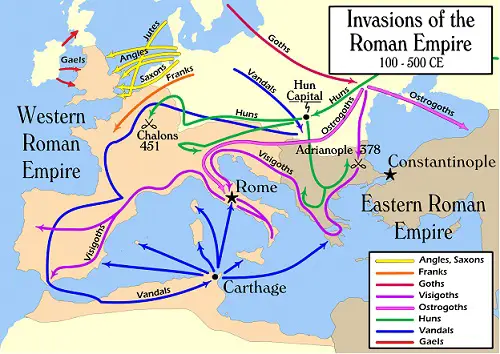
Is this the birth of the 'West'? But how can it be? The Ostrogoths are closely related to the Slavic people. According to some accounts, both the Rus and the Goths are descended from Scandinavians. So whatever unique cultural beliefs make up this mysterious 'Western' essence can surely also be found amongst the people of Eastern Europe?
Islam
Whilst Northern Europe is undergoing this great reshuffle, a Meccan merchant claims to be a prophet in the line of Abraham. After wars to control his native Arabia, the new religion sets its sights on both the east and west, specifically the centres of the religions it plans to replace: Jerusalem, Constantinople and Rome. It rapidly expands into the former Ptolemaic and Seleucid regions and naturally encounters the cosmopolitan ideas of the former Greco-Roman world, especially in Babylon and Alexandria. We know that Arab scholars encounter the philosophy and science of the Greeks as well as the Hindus. Arab scholars make advances in mathematics by adopting the Hindu decimal system as well as the concept of zero.
Islam also pushes west replacing the Vandals in Northern Africa and the Visigoths in Hispania. In 732 AD they get as far as Tours in Francia before being pushed back. Muslim Al-Andalusia becomes a major centre of learning and engagement with Greco-Roman culture.
But the overall impact of Islamic expansion is to split the Mediterranean between a Christian north that stretches from Ireland to Russia and a Muslim south that stretches from Spain deep into the former Seleucid territory.
The Great Schism and the Crusades
Until the Great Schism of 1054 when the Church of Rome formally splits with the Orthodox Church of Constantinople, the Christian world had remained more or less united. Whilst there were certainly regional differences, there was no substantive difference between Latin or Greek Christianity.
A mere fifty years later a largely Frankish army (the Franks had defeated the Muslims at Tours) set out on the first crusade at the request of the Byzantine Emperor Alexios I and the command of Pope Urban II. There are eight crusades in all. Political and religious tensions lead the Franks to sack Constantinople in 1204 as an act of revenge for the previous Massacre of the Latins in 1182.
The Byzantines call the invasion the Frankokratia. Is this when the notion of a distinct 'Western' culture arises: Germanic, White and Catholic?
The Fall of Constantinople and the Renaissance.
1453 is a critical year. Islam finally succeeds in conquering Constantinople. As a result refugee Greek scholars flee to the remaining Christian world, bringing with them precious manuscripts. Whilst some Greco-Roman ideas had already been preserved in Northern European monasteries or made their way via Muslim Spain, the Renaissance was in essence, yet another migration of eastern ideas westward. This migration generated a rebirth in philosophy, natural science, mathematics and the arts. There was a revival of Neoplatonism, Stoicism and even the Scepticism of Pyrrho. This period deals a fatal blow to the zealots in the Church hierarchy. Creative 'humanist' forces are unleashed that lead eventually to the Reformation and the Enlightenment.
Native Americans and European Revolutionaries.
Ask most people what the national dish of Italy is and they'll likely answer pasta with some form of tomato based sauce topped with a sprinkling of cracked black pepper - a dish only made possible through the explorations of Marco Polo and Christopher Columbus. In fact it was black pepper (also highly prized by the Romans) that inspired Columbus to seek an alternative route to India, thus bypassing Arab control of the highly profitable spice trade.
This is all well-understood history. The western coast of Europe had a geographic advantage. With the development of ocean going ships, they were the most likely to encounter the Americas. First the Spanish and Portuguese, followed by the French and British (and not to forget Russia from the opposite direction - Siberia). European colonisation had a devastating impact on the indigenous population of America through the spread of disease, religious zealotry and violence.
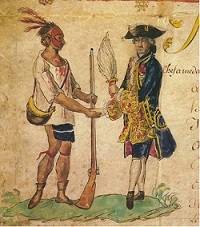
And whilst colonisation had a genocidal impact on indigenous people, it also had an irreversible impact on European thought, especially in France.
There was a wave of literature comparing European civilisation to that of the 'Noble Savage'. Montesquieu imagined a dialogue with a Persian, Diderot a Tahitian, Chateaubriand a Natchez and Voltaire a Huron. Perhaps the most famous was figure was Kandiaronk, a Wendat representative/statesman made famous in a series of books by Louis-Armand de Lom d'Arce (known as Lahontan). It has also been argued that the American Constitution was inspired in part, by the Iroquois Confederation.
The Enlightenment is the beginning of Modernism - a period of great change as northern, Christian Europe encounters radically different cultures.
Capitalism and Communism
Need I point out that Karl Marx and Frederich Engels were Northern Europeans? Marx found asylum in London and wrote a good part of Das Kapital in the British Library. Here's the great contradiction: the most trenchant criticism of the European aristocratic/colonial order comes from Europe itself. The French Revolution overthrew the rule of Church and Monarch. It gave rise to the distinction of left versus right and inspired a host of reform movements, splitting the European political order into three broad factions: the pro-aristocratic Conservatives, the middle-class (and nouveau-riche) Liberals and the working class Socialist/Communist movement.
This necessarily includes the postmodernist critiques. Derrida, Foucault, Gilles and Deleuze, the Critical Theory of the Frankfurt School - all Northern Europeans.
Here's where we come to the real meaning of the 'West' - the capitalist order. In an extraordinary rhetorical sleight of hand, sections of the left magically changed geographical location. They imagine they have ceased to be 'Western'.
But here's the thing. Capitalism is not 'Western' either, it is universal. That's why the Asian nations of Japan, Sth Korea, Taiwan and Singapore have become wealthy. The history of capitalism begins with trade and trade is universal. Most of the cuneiform tablets found in Sumer are records of trade transactions. And like philosophy, science and the arts, the field of economics was subject to innovation: the development of money, the establishment of a legal system to resolve disputes, improvements in accounting, the creation of loans and interest, a secure banking system and eventually investment and the stock market. As I pointed out above, Rome had a trade deficit with India.
So back to the great contradiction. It is all 'Western' - the problem and the solution.
GLOBAL CIVILISATION
The modern era marks the beginning of globalisation. The once backward and barbarian tribes of Northern Europe had undergone a substantial change under the influence of the Middle-Esatern Greco-Roman and Judeo-Christian cultures. Colonisation further exposes Northern Europe to multiple foreign influences. And whilst it is often violent, trade with Northern Europe changes every culture it touches.
New York and Chicago became symbols of America's industrialisation and wealth, with the aptly named Empire State Building becomes world famous. The modern city of skyscrapers is now the pattern for most of the world, from Shanghai, Hong Kong and Tokyo to Kuala Lumpur, Singapore and Dubai. America no longer has the tallest buildings. Five of the top ten are in China.
People often speak of Western Science and Western Medicine. Truth is, they were never 'Western' to begin with. Modern science and medicine is the result of millennia of cultural accumulation, of one discovery leading to another with contributions from brilliant minds from around the world. Mathematical concepts that are developed in India make their way to Babylon where they are improved by Arab scholars. These improvements make their way to European universities. And then the process is reversed. European advances spread throughout the world and are again further improved.
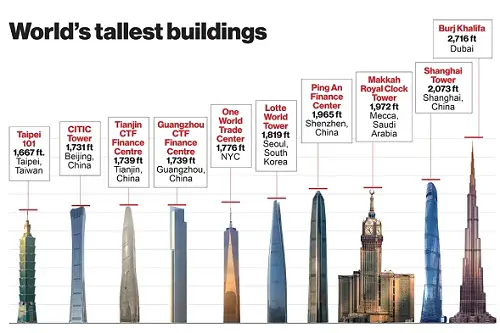
Knowledge and culture are borderless. The Africans enslaved in America bring their culture with them and adapt it to new circumstances. They encounter Western instruments such as the guitar and trumpet and create Jazz and the Blues. Rap and Hip Hop develop on the streets of Black America to find its way to South Korea to be incorporated into K-Pop. Asian martial arts, Hindu yoga and Latin American dance are taught in cities around the world. Fashion, art, music, technology, engineering, medicine, fads, memes - all transmissible across cultures, cycled and recycled. All the major 'Western' cities are now multi-cultural. My home city of Melbourne is made up of people from 200 countries and territories, 233 languages and dialects and 116 religions.
I certainly don't want to overlook the inequalities and injustices of colonisation, but hasn't this always been the case? Japan and China have had a tempestuous relationship. A great deal of Japanese culture originated in China. Japan responded with imperialist expansion into China and Korea, culminating in the brutality of the rape of Nanjing. The Islamic invasion of India cost an estimated 80 million lives. Hindu temples are found in Indonesia and Cambodia. And then there were the Mongols. Before they rose to dominance in the 17th century, Britain had been the subject of multiple waves of colonisation. The Neolithic Stonehenge culture was replaced by Celts from Europe. The Romans replaced the Celts, the Anglo-Saxons replaced the Romans, invading Vikings challenged the Anglo-Saxons until the Normans replaced both.
Hierarchies and Elites
Northern Europeans didn't invent dominator hierarchies, didn't invent feudalism. Once humanity reaches the city-state stage, hierarchy appears naturally: in Mesoamerica, Africa, China, Japan, India, Persia, Greece, Egypt. Everywhere the same pattern: a ruling elite supported by a priestly caste feeding off the peasant or slave class. In Mesoamerica it is literal, with priests sacrificing thousands to appease the gods.

Arab status symbols
It's the same today. Each society creates a wealthy elite that seem to aspire to the same indulgent lifestyle. The rich kids of America have more in common with the rich kids of Russia, India, Arabia or China than they do with the poor. The same desire for luxury goods and status symbols: Lamborghinis, Rolex watches, designer brands, luxury yachts, vacations by private jets to the world's hot spots, properties in London, Paris and New York, bank accounts in tax havens. The same disdain and utter disregard for the poor. The same corruption and political jostling, the same kleptocracy and oligarchy. (As I write this there is a civil war in Sudan as two corrupt generals fight for control of the hierarchy).
Tradition, Identity and Resistance
The process of change isn't easy. There is often strong and violent resistance. Two competing forces are at play: tradition and innovation. The long view of history provides multiple examples of resistance to change. It also provides a paradox: once novel beliefs are normalised and ossify into fixed tradition. Christianity is a good example. It spreads throughout the Roman Empire directly challenging Roman authority. When it becomes the dominant ideology it does exactly what the Romans did, persecute those who question its authority.
One significant location of resistance are the various indigenous rights movements. But even they cannot avoid the paradox. Australian Aborigines were in the unique position of being untouched by outside cultural influences for close to 40,000 years. First contact was devastating: disease, extermination at the hands of settlers, profound cultural shock, and ongoing racial discrimination. An ugly history. Of course Aboriginal people protested, but not through reference to traditional law or traditional concepts, but by adopting the coloniser's concepts of natural justice and human rights. In the 60's the Aboriginal rights movement copied tactics from the US civil rights movement, by the 70's some activists openly embraced left-wing ideologies, in the 80's land rights were affirmed in the coloniser's High Court, and today many speak of intersectionality and solidarity with gay rights and feminism - despite Aboriginal tradition being strictly patriarchal and intolerant of homosexuality. No one is arguing for a complete return to the pre-colonial status quo, rather a new form of hybrid Aboriginality is being created.

Intersectional Aboriginality
The Hypocrites
Despite adopting the thoroughly Western and Modernist political philosophy of Marxism, countries such as Russia, China, Vietnam, Cuba, North Korea are not considered Western. Perhaps people forget what China's cultural revolution was all about: a violent rejection of Chinese tradition. 'The Four Olds' were to be swept aside to be replaced by the thoroughly Western philosophy of Dialectical Materialism.
_“Sweep away all cow demons and snake spirits. Completely eradicate all the old ideas, old culture, old customs and old habits that have poisoned the people of China for thousands of years, fostered by the exploiting classes._”
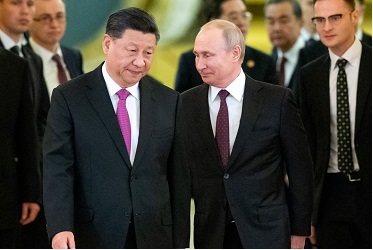
The almost ubiquitous Western suit
Pol Pot took this logic a step further by attempting to reshape Cambodian society in its entirety, causing the death of well over a million.
The history of Korea is near perfect example of the two forms of Western colonisation. At the end of WW2 North Korea was controlled by Russia. The Korean War began when Russia attempted to expand its territory. In North Korea, the Kim dynasty has reshaped Korean culture into a Stalinist cult of the personality. South Korea has become a hyper-capitalist society: long working hours and intense consumerism and social alienation.
To put it simply, Western Imperialism comes in two forms, capitalist and Marxist. The Cold War was a violent competition between these two Modernist movements. The critics who pretend to oppose Western Imperialism are often supporters of a different form of Western Imperialism. It is the epitome of hypocrisy.
With the exception of a few traditional monarchies, most nations have adopted/adapted Western forms of government.
Absurdities
There is no more absurd a concept than the Global South. The term was invented to assuage some politician's sense of pride. Although perfectly accurate, some thought the term developed and developing implied a racist judgment about the capacity of the citizens. It is a pointless change because everyone knows the term Global South really means developing.
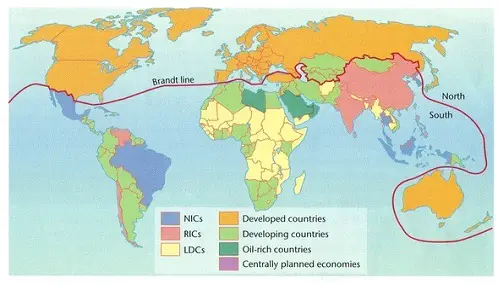
The Brandt Equator
1. Whilst Spain is considered fully part of Europe and therefore White, their direct descendants in South America are designated Latina and People of Colour (POC). It doesn't matter if you are a member of the elite in Argentina, Brazil or Mexico with a direct genetic link to your Spanish ancestors, you are no longer rhetorically White. And despite following the same pattern of colonisation as North America - the violent dispossession of the indigenous people and the importation of slaves from Africa - the region belongs to the Global South and is considered the victim of colonisation.
2. As explained above, the Ancient Greeks were focused on the Middle East, their great rival was Persia. We know that from ancient times the people of the region underwent multiple migrations. This is reflected in the genomes of the region. The story of Troy is about the marriage of a Spartan woman to a Persian king. Yet despite modern day Turkey being once part of Greece, the Greeks are designated European and White and the Turks POC and part of the Global South.
3. If you are a European convert to Islam you similarly change from White to POC and to the Global South.
4. The five most populated nations are in the northern hemisphere: China, India, the USA, Indonesia and Pakistan. Only the USA is in the Global North, the other four belong to the Global South. 42% of the world's population magically shifted hemispheres.
The Hierarchy Remains no Matter who is at the Top
The British Empire was once the largest. Once. After the spectacular own goal of Brexit, the UK struggles to put enough food on its supermarket shelves. There are routine shortages of the basics: eggs, chicken, fresh fruit and vegetables. Global fortunes can change. At the moment the US is at the top of the global hierarchy, but it too seems intent on self-sabotage. It has never been more divided. There are some who welcome a change in the world order. Unfortunately they imagine that a shuffle in the hierarchical order will remove the hierarchy altogether. The people previously oppressed by Western colonialism and the post war neo-liberal order will apparently enter a new world of freedom.
Will they?
China is poised to replace the US, but how will they exercise their dominant position? Judging by their current actions, not well. The Chinese communist party maintains a firm control on freedom of speech and movement. The Chinese people are the most monitored in the world. Rural workers are housed in factory dormitories and forced to work long hours in conditions reminiscent of the sweat shops of the Industrial Revolution in Europe. Chinese mining and forestry corporations in Africa and Asia are just as rapacious as their European counterparts, maintaining private police and using intimidation and corruption to bend politicians to their will. And cultural sensitivity and indigenous rights? Forget it. Just ask the Tibetans and Uyghurs.
Some advocate for the BRICS coalition: Brazil, Russia, India, China and South Africa. How does Brazil treat its indigenous people? Russia has unilaterally invaded Ukraine, ignoring multiple international conventions. India has a serious problem with violence against women, much of it caste based. China is rapidly building its military with the clear aim of controlling SE Asia and South Africa is riddled with corruption. What is the environmental record of each of these nations?
And before you rush to say America is no better. Who is comparing these countries to America? We are talking about Northern Europe so I'm thinking especially of the Nordic block, countries that routinely top the scores on a number of important measures.
Those who want to upend the current order best be careful what they wish for.